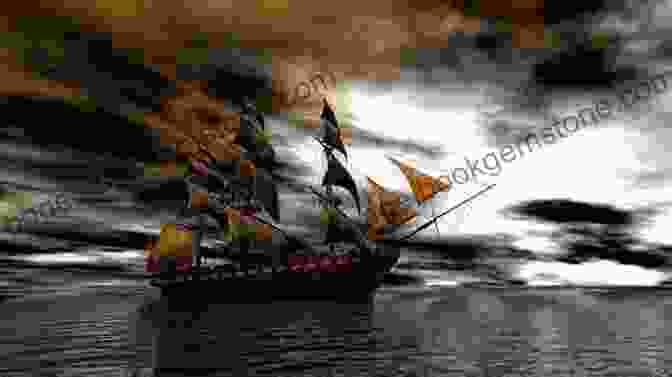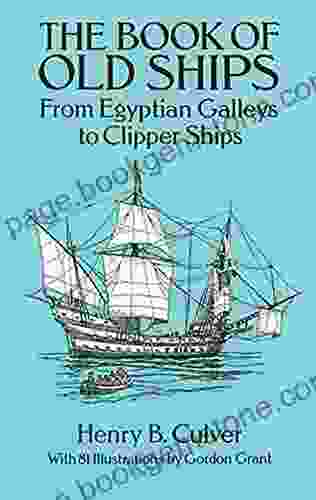Unveiling the Enchanting World of Ancient Ships: A Historical Odyssey Through Maritime Heritage


Ships have played a pivotal role in shaping human history, connecting distant lands, fostering cultural exchange, and enabling exploration and conquest. From the rudimentary rafts of ancient civilizations to the colossal vessels of modern times, the evolution of ships mirrors the advancement of human ingenuity and our enduring fascination with the sea. In this article, we embark on a historical odyssey to explore the captivating world of old ships, uncovering the stories, designs, and significance of these maritime marvels that continue to inspire awe and wonder in our present day.
4.1 out of 5
| Language | : | English |
| File size | : | 15687 KB |
| Text-to-Speech | : | Enabled |
| Screen Reader | : | Supported |
| Enhanced typesetting | : | Enabled |
| Print length | : | 274 pages |
| Lending | : | Enabled |
Ancient Mariners: The Birth of Seafaring
The earliest evidence of seafaring dates back to the Neolithic period, around 6000 BCE. Simple rafts made of reeds, logs, or animal skins allowed ancient peoples to venture into coastal waters for fishing, trade, and exploration. Over time, these rudimentary vessels evolved into more sophisticated designs, featuring sails made from animal skins or woven plant fibers. The Egyptians, known for their advanced shipbuilding techniques, built reed boats capable of navigating the Nile River and the Mediterranean Sea.
The Bronze Age: Expanding Horizons
The Bronze Age (3000-1200 BCE) witnessed significant advancements in shipbuilding, particularly in the Mediterranean region. The Phoenicians, master mariners of their time, developed ships with a distinctive hull shape and a single mast with a rectangular sail. These vessels enabled them to establish a vast maritime empire, spanning from the shores of Lebanon to Spain. The Greeks and Romans also made significant contributions to shipbuilding, developing ships with multiple masts and oars, allowing them to explore and conquer distant lands.
The Iron Age: Seafaring Empires
The Iron Age (1200-500 BCE) marked the rise of seafaring empires, most notably the Greeks and the Persians. Greek triremes, with their three rows of oars, were renowned for their speed and maneuverability, making them formidable warships. The Persians, on the other hand, built massive ships with multiple masts and sails, capable of transporting large armies across vast distances. These ships played a crucial role in shaping the geopolitical landscape of the ancient world.
The Middle Ages: Exploring New Worlds
The Middle Ages (500-1500 CE) saw the emergence of new shipbuilding techniques and the exploration of uncharted territories. The Vikings, known for their daring seafaring expeditions, developed sturdy longships with shallow drafts, allowing them to navigate both open seas and shallow rivers. The Chinese, meanwhile, invented the compass, a groundbreaking navigational tool that revolutionized seafaring. It enabled sailors to determine their direction more accurately, making long-distance travel safer and more efficient.
The Age of Exploration: Unlocking Global Connections
The Age of Exploration (15th-17th centuries) witnessed a surge in shipbuilding and maritime exploration, particularly in Europe. Portuguese and Spanish explorers embarked on ambitious voyages, seeking new trade routes to the East and discovering new continents in the Americas. Ships such as the Santa Maria, piloted by Christopher Columbus, became iconic symbols of this era of exploration and discovery.
The Industrial Revolution: Steam Power and Ironclads
The Industrial Revolution (18th-19th centuries) brought about transformative changes in shipbuilding. The invention of the steam engine revolutionized naval warfare, leading to the development of ironclad warships. These vessels, protected by thick armor plates, were virtually impervious to cannon fire, changing the face of maritime combat forever. Coal-powered steamships also revolutionized commercial shipping, enabling faster and more efficient transportation of goods and passengers across vast oceans.
Modern Ships: Technological Marvels
The 20th and 21st centuries have witnessed the development of increasingly sophisticated ships, incorporating advanced technologies and cutting-edge design. Cargo ships have grown to colossal proportions, transporting massive quantities of goods across the globe. Container ships have revolutionized international trade, making it possible to transport goods in standardized containers, reducing handling time and costs. Supertankers, capable of hauling millions of barrels of oil, have become vital for meeting global energy demands.
Throughout history, ships have served as indispensable tools for exploration, trade, warfare, and cultural exchange. From the humble rafts of ancient mariners to the colossal vessels of today, ships have played a fundamental role in shaping our world. As we continue to push the boundaries of maritime technology, the future holds even more exciting possibilities for the evolution of ships. These floating marvels will undoubtedly continue to inspire awe and wonder, connecting us across oceans and leaving an enduring legacy in the annals of human history and maritime heritage.
4.1 out of 5
| Language | : | English |
| File size | : | 15687 KB |
| Text-to-Speech | : | Enabled |
| Screen Reader | : | Supported |
| Enhanced typesetting | : | Enabled |
| Print length | : | 274 pages |
| Lending | : | Enabled |
Do you want to contribute by writing guest posts on this blog?
Please contact us and send us a resume of previous articles that you have written.
 Best Book
Best Book Page Flip
Page Flip Bookshelf
Bookshelf Literary loom
Literary loom Chapter
Chapter Bookish
Bookish PageTurner
PageTurner Bibliophile
Bibliophile Story
Story Inkwell
Inkwell Bookworm
Bookworm Labyrinth
Labyrinth Plot Twist
Plot Twist Prose
Prose Paperback
Paperback Storyteller
Storyteller Sanctuary
Sanctuary Fiction
Fiction Reading
Reading Chronicle
Chronicle Read
Read Susan Hable
Susan Hable John Kane
John Kane Xueting Christine Ni
Xueting Christine Ni James Huntington
James Huntington Keith Fenwick
Keith Fenwick Jeff Shaara
Jeff Shaara Noa Baum
Noa Baum Annette Gisby
Annette Gisby Scott Pratt
Scott Pratt Sanford Meisner
Sanford Meisner Ryan Dunlavey
Ryan Dunlavey June Mcleod
June Mcleod Ryan Jennings
Ryan Jennings Tina Turner
Tina Turner James Monaco
James Monaco Ruth Behar
Ruth Behar Jennifer Campbell
Jennifer Campbell Pilar M Herr
Pilar M Herr Andrew Loomis
Andrew Loomis Jacqueline Winspear
Jacqueline Winspear W Kamau Bell
W Kamau Bell Phil Chan
Phil Chan Karen Homer
Karen Homer Paula M Block
Paula M Block Matt Zoller Seitz
Matt Zoller Seitz Chris Kennedy
Chris Kennedy V F Gutierrez
V F Gutierrez Jack C Ramsay
Jack C Ramsay Tarry Lindquist
Tarry Lindquist Martin Pistorius
Martin Pistorius Jelani Cobb
Jelani Cobb Jeff Rovin
Jeff Rovin Jasmine Tritten Llc
Jasmine Tritten Llc Victoria Charles
Victoria Charles Honey Phillips
Honey Phillips Laylah Roberts
Laylah Roberts Zia Knight
Zia Knight Slim Dusty
Slim Dusty Michael Curtis
Michael Curtis Jana K Lipman
Jana K Lipman Katrina Rodabaugh
Katrina Rodabaugh Rudolf Koch
Rudolf Koch J D Robb
J D Robb Manny Serrato
Manny Serrato Ronald Bergan
Ronald Bergan John Wilkinson
John Wilkinson Joy Avery
Joy Avery Kiyoshi Takahashi
Kiyoshi Takahashi Willie Mays
Willie Mays Kris Schnee
Kris Schnee Kristen Faber
Kristen Faber Tom Bancroft
Tom Bancroft James Robert Parish
James Robert Parish Jodi Thomas
Jodi Thomas Karen Stocker
Karen Stocker Larry Niven
Larry Niven Jim Mccarthy
Jim Mccarthy Stefan Kottwitz
Stefan Kottwitz Marcy Conway
Marcy Conway John Szpunar
John Szpunar Richard Blanco
Richard Blanco Camilla Townsend
Camilla Townsend Monica Byrne
Monica Byrne Nana Kwame Adjei Brenyah
Nana Kwame Adjei Brenyah Jonathan Drori
Jonathan Drori Charles E Gannon
Charles E Gannon Helena Reckitt
Helena Reckitt Shea Ernshaw
Shea Ernshaw Susan Cross
Susan Cross Sarah Vowell
Sarah Vowell Karpov Kinrade
Karpov Kinrade David Sherwin
David Sherwin John R Kemp
John R Kemp Iris Bolling
Iris Bolling John C Rigdon
John C Rigdon Stephen Smith
Stephen Smith Tanya Tagaq
Tanya Tagaq Mark Willenbrink
Mark Willenbrink Kevin Budelmann
Kevin Budelmann Damon Tweedy
Damon Tweedy Susan Kesler Simpson
Susan Kesler Simpson Karen Lindeman
Karen Lindeman Kent Blansett
Kent Blansett James Joseph
James Joseph Michael Kluckner
Michael Kluckner Marilyn Laura Bowman
Marilyn Laura Bowman Darby Penney
Darby Penney Jean Paul Labourdette
Jean Paul Labourdette Nicholas Sammond
Nicholas Sammond Italo Calvino
Italo Calvino Traci Bunkers
Traci Bunkers Baby Professor
Baby Professor Shonda Buchanan
Shonda Buchanan Jansen Art Studio
Jansen Art Studio Mitchell Albala
Mitchell Albala Jan Cohen Cruz
Jan Cohen Cruz Vikki Haffenden
Vikki Haffenden Kate Rawles
Kate Rawles Justin M Monehen
Justin M Monehen Roger Zelazny
Roger Zelazny Ross Buzzell
Ross Buzzell Marc Foster
Marc Foster Steve Kaffen
Steve Kaffen Kathryn Stockett
Kathryn Stockett Kat Varano
Kat Varano Motorcycle Vagabonds
Motorcycle Vagabonds Deborah Frisch
Deborah Frisch James E Seaver
James E Seaver Roxanne Modafferi
Roxanne Modafferi Dr Lucie Rivera
Dr Lucie Rivera J R Ward
J R Ward Maitland Mcdonagh
Maitland Mcdonagh Kim Fairley
Kim Fairley Sarah Simon
Sarah Simon Bruce Hanington
Bruce Hanington Paul Bonnet
Paul Bonnet Jazz E
Jazz E Sonya Lajuan
Sonya Lajuan Kenneth French
Kenneth French Interweave Editors
Interweave Editors Kevin Ikenberry
Kevin Ikenberry Shawn Levy
Shawn Levy James Graham Baker
James Graham Baker Rani St Pucchi
Rani St Pucchi Julia Rothman
Julia Rothman Tim Fisher
Tim Fisher Steve Parker
Steve Parker Jean M Roberts
Jean M Roberts Merry White
Merry White Marjorie R Williams
Marjorie R Williams Iain Rob Wright
Iain Rob Wright Yvonne Moore
Yvonne Moore Stefhen F D Bryan
Stefhen F D Bryan Travis Rieder
Travis Rieder Jessica Shorstein
Jessica Shorstein Robyn Carr
Robyn Carr Jeneane Lunn
Jeneane Lunn Marcello Di Cintio
Marcello Di Cintio Joe Haldeman
Joe Haldeman J L Heilbron
J L Heilbron Martin Ursell
Martin Ursell Steph The Hammer Hammerman
Steph The Hammer Hammerman Loet Velmans
Loet Velmans Kai Kupferschmidt
Kai Kupferschmidt Ian Condry
Ian Condry Ben Shahn
Ben Shahn Insight Guides
Insight Guides John Clifford
John Clifford Jennifer Lynne Matthews Fairbanks
Jennifer Lynne Matthews Fairbanks Peter Parr
Peter Parr Matthew Israel
Matthew Israel Northrop Davis
Northrop Davis John Tateishi
John Tateishi J Nell
J Nell Suhas Mantri
Suhas Mantri Jim Marrs
Jim Marrs Jonathan Jones
Jonathan Jones Patti M Hall
Patti M Hall Melissa Maerz
Melissa Maerz Ian Littlewood
Ian Littlewood Renae Anderson
Renae Anderson Lauren Francis Sharma
Lauren Francis Sharma Kresley Cole
Kresley Cole Washington Irving
Washington Irving Robert B Pippin
Robert B Pippin Nora Ephron
Nora Ephron Jo Goodman
Jo Goodman Keith Osborn
Keith Osborn Kindle Edition
Kindle Edition Jason Kander
Jason Kander Vicky Gray
Vicky Gray Tim Testu
Tim Testu Bonny Snowdon
Bonny Snowdon E M Hardy
E M Hardy Stephanie Nicole Norris
Stephanie Nicole Norris Vera Nazarian
Vera Nazarian Peter F Stevens
Peter F Stevens Regine Abel
Regine Abel Jonas Peters
Jonas Peters Larry Loftis
Larry Loftis Sonia Sotomayor
Sonia Sotomayor Tim Jeal
Tim Jeal Alec Potrero
Alec Potrero Leonard Barkan
Leonard Barkan Marisa Renee Lee
Marisa Renee Lee Jami Gigot
Jami Gigot Jane Goodall
Jane Goodall John Joseph Adams
John Joseph Adams John Pike
John Pike J J Mcavoy
J J Mcavoy James Claflin
James Claflin Kate Flint
Kate Flint Paul Gauguin
Paul Gauguin John Hindmarsh
John Hindmarsh Isabel Wroth
Isabel Wroth Nat Segnit
Nat Segnit Steven W Brallier
Steven W Brallier Victoria Lewis
Victoria Lewis Mary Antin
Mary Antin Julian Curry
Julian Curry Kaitlyn Dornbier
Kaitlyn Dornbier Ran Walker
Ran Walker J A Hinds
J A Hinds Linda Langner
Linda Langner Manoah Bowman
Manoah Bowman Mary Anne Dorward
Mary Anne Dorward Martin Gilbert
Martin Gilbert Reymundo Sanchez
Reymundo Sanchez Joscha Remus
Joscha Remus Mike Brooks
Mike Brooks Joyce Yee
Joyce Yee Tessa Fontaine
Tessa Fontaine William Gibson
William Gibson Linda Lael Miller
Linda Lael Miller Supersummary
Supersummary P Scott Cunningham
P Scott Cunningham Jeff Howard
Jeff Howard John Lawson
John Lawson Mira Schor
Mira Schor Julia Fowler
Julia Fowler John Potvin
John Potvin Karen Attman
Karen Attman Jay Brian Schoonmaker
Jay Brian Schoonmaker Jeff Vandermeer
Jeff Vandermeer Tasha Black
Tasha Black Waheed Arian
Waheed Arian Ilana Kurshan
Ilana Kurshan Ja Huss
Ja Huss Mauricio Savarese
Mauricio Savarese Robert D Young
Robert D Young James Halliday
James Halliday Morris Rossabi
Morris Rossabi Jeff Hobbs
Jeff Hobbs Mimi Thorisson
Mimi Thorisson Hiroko Yoda
Hiroko Yoda P J Thorndyke
P J Thorndyke Kathryn Warner
Kathryn Warner Ishmael Beah
Ishmael Beah James Hall
James Hall Thomas Lamosse
Thomas Lamosse Karen Hull
Karen Hull Hillary S Webb
Hillary S Webb Patti Mollica
Patti Mollica Stephen T Moskey
Stephen T Moskey Michelle Rial
Michelle Rial Joan Mellen
Joan Mellen Ping Fu
Ping Fu Johno Ellison
Johno Ellison Lynn H Nicholas
Lynn H Nicholas Kira Salak
Kira Salak Hourly History
Hourly History Jimmy O Yang
Jimmy O Yang Michael Peter Bolus
Michael Peter Bolus Mary Jordan
Mary Jordan Amanda Arneill
Amanda Arneill Tom Santopietro
Tom Santopietro Mark Griffin
Mark Griffin E H Raskin
E H Raskin Sheila Simkin
Sheila Simkin Obaidur Rahaman
Obaidur Rahaman Kevin Hart
Kevin Hart Tade Thompson
Tade Thompson Mary Taylor Simeti
Mary Taylor Simeti Lina Acevedo
Lina Acevedo Philip Gourevitch
Philip Gourevitch Sean Wallace
Sean Wallace Hattie Gossett
Hattie Gossett Eva Van Loon
Eva Van Loon Lally Brown
Lally Brown Shirtaloon
Shirtaloon Wayne J Lutz
Wayne J Lutz Weston Ochse
Weston Ochse Will Castro
Will Castro Stephen Hunter
Stephen Hunter Martina M Lanier
Martina M Lanier K C Mills
K C Mills Marcus Samuelsson
Marcus Samuelsson Jim Hutchinson
Jim Hutchinson Melissa Washburn
Melissa Washburn Joe Posnanski
Joe Posnanski Tom Dunkel
Tom Dunkel E C Godhand
E C Godhand Juliette Aristides
Juliette Aristides Rob Wareing
Rob Wareing Neal Stephenson
Neal Stephenson Jason Waguespack
Jason Waguespack Lali Duperti
Lali Duperti Jim Forest
Jim Forest Paul Arthur Berkman
Paul Arthur Berkman Maureen T Corrigan
Maureen T Corrigan Butch Hartman
Butch Hartman Danielle Joseph
Danielle Joseph Jeanine Cornillot
Jeanine Cornillot Ron Collins
Ron Collins Shi Davidi
Shi Davidi Yvonne Claypole
Yvonne Claypole Second Edition Kindle Edition
Second Edition Kindle Edition Bob Wilbanks
Bob Wilbanks Nancy Mitford
Nancy Mitford Thefirstdefier
Thefirstdefier David Lynch
David Lynch Patricia Sands
Patricia Sands Stephen Orr
Stephen Orr Nancy Marie Mithlo
Nancy Marie Mithlo Steve Charney
Steve Charney Jason Fry
Jason Fry Julia L Foulkes
Julia L Foulkes Jason Cochran
Jason Cochran James Baldwin
James Baldwin Jon Steel
Jon Steel Jesmyn Ward
Jesmyn Ward Marc Dipaolo
Marc Dipaolo Uri Mcmillan
Uri Mcmillan Jessica Alba
Jessica Alba Susan Zwerman
Susan Zwerman Phoebe Hoban
Phoebe Hoban Ted Chiang
Ted Chiang Ivy Mix
Ivy Mix Carol Miller
Carol Miller Walter Mosley
Walter Mosley Kimberly Wilkes
Kimberly Wilkes Jessica Gadziala
Jessica Gadziala Jerry Saltz
Jerry Saltz J Nichole
J Nichole Mary Turzillo
Mary Turzillo Paul Carter
Paul Carter Slim Randles
Slim Randles Sherelle Green
Sherelle Green Niqua Nakell
Niqua Nakell Peter Watts
Peter Watts Christina Sharpe
Christina Sharpe Ava Archer
Ava Archer Jack Campbell
Jack Campbell Kristal Wick
Kristal Wick Rosie Rivera
Rosie Rivera J Foord
J Foord Janet Adler
Janet Adler Johanna Lindsey
Johanna Lindsey Mel Dau
Mel Dau Jeanne St James
Jeanne St James Ida B Wells
Ida B Wells Jeffery J Dyas
Jeffery J Dyas Luis J Rodriguez
Luis J Rodriguez Elinor Lipman
Elinor Lipman Suzanne Brooker
Suzanne Brooker Sam Pivnik
Sam Pivnik John Man
John Man C J Cherryh
C J Cherryh Ramez Naam
Ramez Naam Una Mccormack
Una Mccormack Kia Jones
Kia Jones Jason L Riley
Jason L Riley Jerry Vermilye
Jerry Vermilye William Gray
William Gray Tiffany Haddish
Tiffany Haddish Vincent Miller
Vincent Miller Joshua Glenn
Joshua Glenn Jennifer L Scott
Jennifer L Scott Mary Heron Dyer
Mary Heron Dyer Kim Dana Kupperman
Kim Dana Kupperman Karin Evans
Karin Evans Roy Liebman
Roy Liebman Tyanna
Tyanna James Hunter
James Hunter Lisa Wixon
Lisa Wixon Isaac Asimov
Isaac Asimov Zogarth
Zogarth Theodore Menten
Theodore Menten Mariam V Lawal
Mariam V Lawal Martha Maccallum
Martha Maccallum Travis Jeppesen
Travis Jeppesen John Berger
John Berger Jeremy Black
Jeremy Black John Preston
John Preston J T Nicholas
J T Nicholas M William Phelps
M William Phelps Roy John
Roy John Taylor Moore
Taylor Moore Jasper T Scott
Jasper T Scott Kyle Anthony
Kyle Anthony K Webster
K Webster Norman Eisen
Norman Eisen Lonely Planet
Lonely Planet Jodi Ellen Malpas
Jodi Ellen Malpas Tanav Patkar
Tanav Patkar Laura Slater
Laura Slater William L Iggiagruk Hensley
William L Iggiagruk Hensley Marian Lindberg
Marian Lindberg Plutarch
Plutarch Ariel Sabar
Ariel Sabar Patrick Dimarchi
Patrick Dimarchi Jean Johnson
Jean Johnson Hilary Wilson
Hilary Wilson James Barrington
James Barrington Zuri Day
Zuri Day Rolf Giesen
Rolf Giesen Michael Harkins
Michael Harkins Lauren Bastide
Lauren Bastide Theo Farrington
Theo Farrington Joe Garcia
Joe Garcia Nancy Ditomaso
Nancy Ditomaso Dean Dalton
Dean Dalton Stephen L Carter
Stephen L Carter Margaret Hermes
Margaret Hermes Steve Stevenson
Steve Stevenson Marion Zimmer Bradley
Marion Zimmer Bradley Philip Gwynne Jones
Philip Gwynne Jones William Reyland
William Reyland D K Holmberg
D K Holmberg David Railton
David Railton Parnaz Foroutan
Parnaz Foroutan Richard Lecocq
Richard Lecocq James H Cobb
James H Cobb Laureen Nussbaum
Laureen Nussbaum Howard W French
Howard W French Kandra Churchwell
Kandra Churchwell Melissa Fehr
Melissa Fehr Lizzie Damilola Blackburn
Lizzie Damilola Blackburn Vaneetha Risner
Vaneetha Risner Henri Piquer
Henri Piquer Ruth Superhal
Ruth Superhal Quentin Tarantino
Quentin Tarantino Russell Smith
Russell Smith Michael Moorcock
Michael Moorcock Jaime Lowe
Jaime Lowe Katharine Branning
Katharine Branning Eric Vall
Eric Vall Judy Gay Matthews
Judy Gay Matthews Carlyn Beccia
Carlyn Beccia Jeffrey B Perry
Jeffrey B Perry Pat Kramer
Pat Kramer Steve Hulett
Steve Hulett Jacquelyn Descanso
Jacquelyn Descanso John Guy
John Guy Tricia Cornell
Tricia Cornell Mike Downs
Mike Downs Laurie Tom
Laurie Tom Jonathan Dehart
Jonathan Dehart Marty Sklar
Marty Sklar Justin Sloan
Justin Sloan Bianca Del Rio
Bianca Del Rio Languages World
Languages World John Armstrong
John Armstrong David Menconi
David Menconi Lisa Kleypas
Lisa Kleypas Jean Muenchrath
Jean Muenchrath James Lawson
James Lawson Joshua Dalzelle
Joshua Dalzelle Sylvia Townsend Warner
Sylvia Townsend Warner Jean Hugard
Jean Hugard Susie Hodge
Susie Hodge Jan Wahl
Jan Wahl Yuta Aoki
Yuta Aoki R G Richardson
R G Richardson Dorit Elisha
Dorit Elisha Brandon Taylor
Brandon Taylor Tom Swimm
Tom Swimm Henry B Culver
Henry B Culver Fran Macilvey
Fran Macilvey Katherine Arden
Katherine Arden Brian Trent
Brian Trent Steven Konkoly
Steven Konkoly Stuart Woods
Stuart Woods Rick Scott
Rick Scott Lorna Jane Harvey
Lorna Jane Harvey Richard R Brettell
Richard R Brettell Arthur Miller
Arthur Miller Tom Segev
Tom Segev Valerie Wilson Wesley
Valerie Wilson Wesley John Scotney
John Scotney Konchog Lhadrepa
Konchog Lhadrepa Nelson George
Nelson George Louis L Amour
Louis L Amour Hilary Bradt
Hilary Bradt Jd Chandler
Jd Chandler Robert C Wood
Robert C Wood Michael Hone
Michael Hone Patrick Dennis
Patrick Dennis Roger Ebert
Roger Ebert Bruce Cook
Bruce Cook Lee J Ames
Lee J Ames Susan Nagel
Susan Nagel Veronica Li
Veronica Li James Anthony
James Anthony Michael Roberts
Michael Roberts Irene Latham
Irene Latham Jason Kingsley
Jason Kingsley Ryan Leslie
Ryan Leslie Melanie Clarke
Melanie Clarke Jacquie Abram
Jacquie Abram Henry David Thoreau
Henry David Thoreau S J A Turney
S J A Turney Brad Goreski
Brad Goreski Kay Doherty Bennett
Kay Doherty Bennett Ramie Targoff
Ramie Targoff Roland Kelts
Roland Kelts Nolan Clark
Nolan Clark Robin Hobb
Robin Hobb Vaughn Patillo
Vaughn Patillo Maeve Binchy
Maeve Binchy Jason Cranford Teague
Jason Cranford Teague Henry Hemming
Henry Hemming James R Rush
James R Rush Natalie Livingstone
Natalie Livingstone Meredith Talusan
Meredith Talusan Isabel Santos
Isabel Santos Jack London
Jack London Kaoru Nonomura
Kaoru Nonomura Mark Rothko
Mark Rothko Jack Hitt
Jack Hitt Sarah Jackson
Sarah Jackson James Grant
James Grant T O Smith
T O Smith James J Downes
James J Downes Jeff Blumenfeld
Jeff Blumenfeld Thomas Weisser
Thomas Weisser Phillip Barlag
Phillip Barlag R Brady Frost
R Brady Frost J D Sullivan
J D Sullivan Misty Copeland
Misty Copeland Tom Glover
Tom Glover Michael Head
Michael Head Sianne Ngai
Sianne Ngai Nobuko Miyamoto
Nobuko Miyamoto Sally R Ball
Sally R Ball Thomas J Campanella
Thomas J Campanella Stephen Kurkjian
Stephen Kurkjian Steve Berry
Steve Berry Shirish Deshpande
Shirish Deshpande Seth Rain
Seth Rain Maria Adolfsson
Maria Adolfsson Laura Beth Love
Laura Beth Love Sandra M Z Armstrong
Sandra M Z Armstrong Laxuri Art
Laxuri Art Steve Spill
Steve Spill Edoardo Albert
Edoardo Albert Pete Salgado
Pete Salgado Volta Voloshin Smith
Volta Voloshin Smith Judy Friesem
Judy Friesem Jeff Mellem
Jeff Mellem Stef Smulders
Stef Smulders Lisa Edwards
Lisa Edwards Terrance Zepke
Terrance Zepke Megan Mackie
Megan Mackie M D Cooper
M D Cooper Robert Rosen
Robert Rosen Viet Thanh Nguyen
Viet Thanh Nguyen Joe Fig
Joe Fig Joshua T Calvert
Joshua T Calvert James Patterson
James Patterson Marjorie Agosin
Marjorie Agosin Michael Dooley
Michael Dooley Janet Carlson
Janet Carlson Reid Mitenbuler
Reid Mitenbuler Ulrike Fuchs
Ulrike Fuchs Ilene Strizver
Ilene Strizver Jose Vadi
Jose Vadi James Fairbairn
James Fairbairn Ian Blakemore
Ian Blakemore Zack Meisel
Zack Meisel Harold Speed
Harold Speed Isak Dinesen
Isak Dinesen Samantha Irby
Samantha Irby Leslie Marmon Silko
Leslie Marmon Silko Robert Mccammon
Robert Mccammon Lawrence Durrell
Lawrence Durrell Henry Fraser
Henry Fraser Todd Wassel
Todd Wassel Pierre Pochet
Pierre Pochet James Swallow
James Swallow Zanna Goldhawk
Zanna Goldhawk Julia Zarankin
Julia Zarankin Karen Cheng
Karen Cheng
Light bulbAdvertise smarter! Our strategic ad space ensures maximum exposure. Reserve your spot today!

 Douglas FosterStories of Your Life and Others: A Journey Through Time, Language, and the...
Douglas FosterStories of Your Life and Others: A Journey Through Time, Language, and the...
 Maurice ParkerThe Bizarre and Often Sordid Passings of More Than 125 American Movie and TV...
Maurice ParkerThe Bizarre and Often Sordid Passings of More Than 125 American Movie and TV... Benjamin StoneFollow ·6.4k
Benjamin StoneFollow ·6.4k Junichiro TanizakiFollow ·9.4k
Junichiro TanizakiFollow ·9.4k Christopher WoodsFollow ·13k
Christopher WoodsFollow ·13k Cole PowellFollow ·2.6k
Cole PowellFollow ·2.6k Ed CooperFollow ·18.4k
Ed CooperFollow ·18.4k Felix HayesFollow ·12k
Felix HayesFollow ·12k Sam CarterFollow ·19.7k
Sam CarterFollow ·19.7k E.M. ForsterFollow ·9.1k
E.M. ForsterFollow ·9.1k

 Holden Bell
Holden BellFriend Indeed One: A Comprehensive Guide to the Essential...
In the tapestry of human existence,...

 Gustavo Cox
Gustavo CoxBend Not Break: Life in Two Worlds
In the tapestry of human...

 Andy Hayes
Andy HayesDiscover How To Create Stunning Images With Useful And...
Drawing is a great way to...

 Aleksandr Pushkin
Aleksandr PushkinThe Rise and Fall of Latin Queen: An Exploration into the...
Latin music has captivated audiences...

 Ira Cox
Ira CoxUnveiling the Soul of Desert Painting: A Journey into the...
In the vast...
4.1 out of 5
| Language | : | English |
| File size | : | 15687 KB |
| Text-to-Speech | : | Enabled |
| Screen Reader | : | Supported |
| Enhanced typesetting | : | Enabled |
| Print length | : | 274 pages |
| Lending | : | Enabled |










